Report
FOLENS Seminar December 2012: Fukushima Visit – Life and Agriculture after Tohoku Earthquake and Fukushima Nuclear Disaster
Student's reports:TANG SI HIEP ![]() Tomohisa Matsushita
Tomohisa Matsushita![]() Rimi Tohno
Rimi Tohno![]() Rashied Tetteh
Rashied Tetteh![]() Rahman Md Hasnat
Rahman Md Hasnat![]() Piyanuch Jaikaew
Piyanuch Jaikaew![]() AUNG ZAW OO
AUNG ZAW OO![]() Omari Ansong Richard
Omari Ansong Richard![]() Nam Nguyen
Nam Nguyen![]() Mizuki Hasegawa
Mizuki Hasegawa![]() MISHYNA MARYIA
MISHYNA MARYIA![]() Magatt Thiam
Magatt Thiam![]() MOHAMMED ZIA UDDIN KAMAL
MOHAMMED ZIA UDDIN KAMAL![]() Mohammad Sahin Polan
Mohammad Sahin Polan![]() Li Zhenhao
Li Zhenhao![]() Lorn Vicheka
Lorn Vicheka![]() Katsura TSUKANO
Katsura TSUKANO![]() JOLLIBEKOV VLADIMIR
JOLLIBEKOV VLADIMIR![]() Hadian Permana
Hadian Permana![]() Hiromitsu MORIYAMA
Hiromitsu MORIYAMA![]() Hossein Mardani
Hossein Mardani![]() Fumi OKURA
Fumi OKURA![]() Emi Nagata
Emi Nagata![]() Elena KAZANTSEVA
Elena KAZANTSEVA![]() Co Thi Kinh
Co Thi Kinh![]() Bui Xuan Dung
Bui Xuan Dung![]()
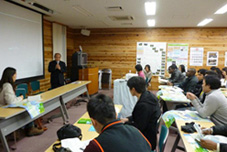 |
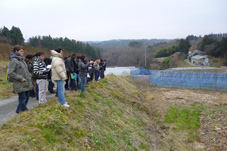 |
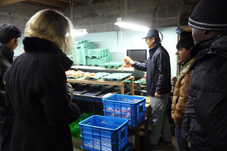 |
| Talk by Mr. Masatoshi Muto, Executive Director, Committee for organic farming and community development in Towa: “Model for Reducing Contamination and Reconstructing Agriculture” |
On-site lecture by Assoc. Prof. Sonoko Dorothea Bellingrath-Kimura about her study to reduce radioactive materials in farm soils | Learning about crops produced in each farm inn such as apples, mushrooms, and green onions |
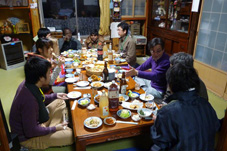 |
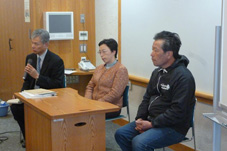 |
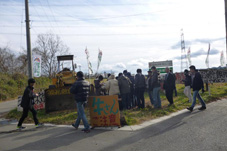 |
| Learning about rural life and impacts of radiation contamination with a dinner of delicious local food at a farm inn | Lecture and Q&A with Ms. Mikako Takahashi, a local leader, and Mr. Masami Yoshizawa of “Farm of Hope”, in Minamisouma | Entrance to Farm of Hope where cattle left in a restricted zone are gathered and protected |
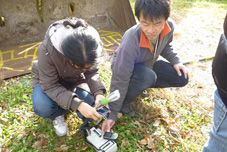 |
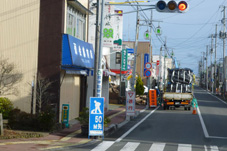 |
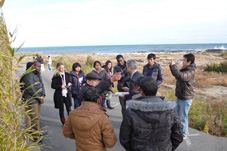 |
| Measuring air radiation levels | Downtown Odaka of Minamisouma where houses collapsed by the earthquake are being removed after being categorized as “the area to which evacuation orders are ready to be lifted” | Visit to a district of Odaka attacked by tsunami, guided by Mr. Yoshiki Konno telling the situation on 11 March and after |
A team of 28 students (26 FOLENS and 2 others) and 7 faculty members visited Fukushima on 17-18 December, as part of the seminar series on
“Life and Agriculture after Tohoku Earthquake and Fukushima Nuclear Disaster” between November 2012 and January 2013. The destinations
were Towa District of Nihonmatsu City (Day 1), Iitate and Minamisouma (Day 2), where we met various people striving in difficult situations
following the earthquake and nuclear power plant accident. Our aims were to 1) learn from the current situation of people’s lives and agriculture,
and the various actions being taken in local communities; and 2) deepen thoughts on how issues in Fukushima, students’ own communities, and the
world, are connected, how such issues and their own specialty fields can be connected, and what action they can actually take.
Day 1:
Towa District of Nihonmatsu City, with its local committee Yuki no Sato Towa Furusatozukuri Kyougikai (Committee for Organic Farming and Community Development
in Towa) as a contact point, has cooperated with researchers from several universities since before the accident. After the disaster, their cooperation has
focused on research to understand the situation of radiation contamination in the area and to implement actions for the recovery of agriculture. In this visit,
Mr. Masatoshi Muto, Executive Director of the Committee, explained their activities. After that, we visited a research site of Assoc. Prof. Sonoko Dorothea
Bellingrath-Kimura, where she introduced her study on the reduction of radioactive materials in farm soils. Assoc. Prof. Takashi Gomi also explained about
the relationship between the geographical formation and radionuclide transfer.
The team was then divided into five groups for a visit and stay at farm inns in the district. At each farm inn, the participants spent several hours working and
talking with the farm inn owners and their family to learn about rural life, agriculture, and impacts of radiation contamination on them. Some of the groups
enjoyed KOTATSU, or a heating table, a traditional heating appliance in Japan. For some of the participants, it was the first time to visit a farm in Japan.
The richness of rural life, delicious meals with local food, and great hospitality impressed many of us. At the same time, it was a valuable opportunity for
all to think about the nuclear power generation and its issues once again.
Day 2:
After leaving farm inns and Towa, we headed to Minamisouma by bus. On the way, we drove through Iitate Village, which has been incorporated into the Deliberate
Evacuation Area due to the high level of radiation contamination, although it is totally out of the 20km zone or even mostly out of the 30km zone. Mr. Junya Sano,
the local coordinator of the visit, explained the sustainable community development activities in Iitate that has been known as one of the “most beautiful villages
in Japan”, and the life and action of Iitate residents under evacuation.
In Minamisouma, we had a lecture by four speakers: Ms. Mikako Takahashi, who has been an active leader of Minamisouma residents; Mr. Youdou Takeuchi of Minna Mirai
Center (Everyone Future Center); Mr. Masami Yoshizawa of Farm of Hope, who protects cattle left in the restricted zone; and Mr. Yoshiki Konno of Odaka District,
the area of Minamisouma severely attacked by tsunami. Their talks included hardships and challenges caused by the earthquake and the accident, actions to face such
challenges, their thoughts while going through such experience, and messages for the participants. After lunch with the speakers, we visited Farm of Hope, which is
at the border between Minamisouma and Namie Town. We also visited downtown Odaka where no one is allowed to live yet, and also the coastal area where cars and houses
collapsed by tsunami still remain. All of us were shocked to actually see the serious outcomes of the earthquake, the tsunami, and the nuclear power plant accident.
On the way back, the students shared their impressions of the trip: “What I remember most from this visit is the division of people after the accident, for example,
between generations, family members, and evacuates in different places. I want to do something.”; Young people should know more about Fukushima, but it is also true
that the more I know, the more I’m confused. I don’t know what is actually right. I need to think more,”; “It was good to visit and actually see the site although
I knew some about tsunami and nuclear power plant accident from media. In my country there is also a plan to establish a nuclear power plant. I think thorough
inspection is necessary”. More complete reports by students will be linked to this page as soon as they are ready. (SN)
Program:
Day1 (17 December)
6:40 Meet at Main Gate (in front of Main Building/HONKAN), TUAT Fuchu Campus
7:00 Depart (Bus)
・Orientation: Ninomiya-Lim
・Lecture/Talks: …
11:30 Arrive in Towa Roadside Station, Nihonmatsu City, Fukushima Pref. (道の駅ふくしま東和)
Talk by Mr. Masatoshi Muto, Executive Director, Committee for Organic Farming and Community Development in Towa: Satoyama Recovery and Sisaster Restoration Program
– Model for Reducing Contamination and Reconstructing Agriculture – What we see in the second year of the disaster
http://www.touwanosato.net/kyougikai.html
13:00 Lunch
14:00 Visit Research Sites of TUAT Faculty (Kimura/ Gomi)
14:45 Go to Farmer’s Guest Houses/ Work and Talk with Farmers in Towa
Dinner & Sleep at Farmer’s Guest Houses
Day2 (18 December)
7:45 Meet at Towa Roadside Station
8:00 Depart
Go through Iitate – Talk on Situation of Iitate – known as one of "the most beautiful villages" in Japan but now a restricted zone (Sano)
9:30 Arrive in Minami Souma City
10:00 Talks on Situation of Minamisouma & Namie Area after the Earthquake and Nuclear Disaster
・10:00-10:30 Ms. Mikako Takahashi (CEO, Hokuyosha Cleaning Company/ Tsunagaro Minamisouma): Local Community’s Life after the Earthquake and Nuclear Disaster
http://www.hokuyosha.com/
・10:30-10:45 Mr. Youdou Takeuchi (Minna Mirai Center): Activities of Minna Mirai Center as a Base of Civic Action
http://www.facebook.com/minnamirai
・10:45-11:30 Mr. Masami Yoshizawa (Representative, Farm Sanctuary Fukushima): Situation of Livestock in Evacuated Zone
http://fukushima-farmsanctuary.blogzine.jp/
11:50 Go to Restaurant Shokusaian
12:00 Lunch with Speakers /Those who finish early can visit Minna Mirai Center (Everyone Future Center)
12:45 Bus
・Odaka – the area afflicted by tsunami: Guided by Mr. Yoshiki Konno, Head of Tsukahara District, Odaka
・Farm Sanctuary Fukushima (Only to the gate (1.5μ㏜/h) as the radiation level inside the farm is as high as 3μ㏜/h. Those who wish to get off the bus can do so.)
15:00 Depart
21:00 Arrive in TUAT Fuchu Campups